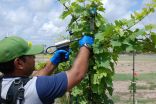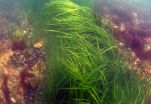(Press-News.org) COLLEGE STATION -- It's happy hour at a lab in College Station. The cocktail of choice, developed by scientists with Texas A&M AgriLife Research, is one that stops or prevents the deadly Pierce's disease on wine grapes.
The discovery could turn a new leaf on the multimillion-dollar U.S. wine industry. Hear, hear.
The study, published in the academic journal PLOS ONE, describes the use of four bacteriophages that were identified for their ability to attack the bacteria that causes the devastating disease in grapes and several other plants.
A bacteriophage, or phage, is a virus that attacks bacteria. Because they are abundant in the environment, scientists are trying to learn more about the different types and what specific bacteria each can attack. Scientists at AgriLife Research were able to isolate four phages that specifically target Xylella fastidiosa, the culprit in Pierce's disease.
"The bacteria Xylella fastidiosa is native to the United States and causes disease in many plants including grapevines, oaks, peaches, almonds, coffee and citrus," said Dr. Carlos Gonzalez, an AgriLife Research plant pathologist in College Station. "We have imported most of our grapevines from Europe, and so therefore the pathogen and the host - in this case the grapevine - did not co-evolve. That made the grapevines susceptible."
The offending bacteria makes its way to plants via insects. In wine grapes, it's the glassy-winged sharpshooter. When the insect feeds on a plant, the bacteria is transmitted inside the plant where it travels throughout the xylem vessels, infecting as it goes. The resulting condition, called Pierce's disease, can cause a vineyard to die in anywhere from a few months to a few years after infection, according to Jim Kamas of Fredericksburg, Texas A&M AgriLife Extension Service horticulturist and outreach coordinator for the Texas Pierce's Disease Research and Education Program.
"Instead of feeding on the leaves of a plant, the glassy-winged sharpshooter feeds on the cane of a grapevine and therefore spreads the bacterium much more efficiently," Gonzalez explained.
The insect, about the size of a grain of rice, could feed its way into an estimated $24.6 billion of California wine sales in the U.S., according to the Wine Institute, and the Texas Wine and Grape Growers Association' estimated $1.88 billion of economic value to the state.
Stopping the rampage with potential to make such an enormous dent in food and beverage supply heretofore relied on insecticides aimed at the carrier bugs.
However, the group of insecticides used have been shown to have adverse effects on beneficial insects such as honeybees and have already been banned in Europe, the scientists said. These concerns lead them to seek a biocontrol, or more natural way of preventing and treating diseases caused by Xylella fastidiosa, said Gonzalez, who also is part of the Center for Phage Technology in College Station where the research was done.
"Our approach basically was to directly address the bacterium that causes the disease rather than focus on the insect," Gonzalez said of his colleagues at the center, Drs. Ry Young, Mayukh Das and Tushar Suvra Bhowmick. "The phage treatment offers an alternative to pesticides for the treatment of diseases caused by Xylella fastidiosa."
Young said the idea of a phage cocktail is to include several different phages so that if a bacterial strain becomes resistant to one of the phages, then it will be killed by the others.
"Like the famous boxer Jack Dempsey said, 'if my right hand don't get ya, my left hand will.' That's pretty much how the cocktails work," said Young, the center's director.
But finding the right mix isn't easy, the researchers said.
Das, Bhowmick and then-graduate student Stephen Ahern isolated numerous phages to examine their genetic diversity.
"We have a phage bank with more than 100 phages," Bhowmick said. "We picked the four candidates - known as Sano, Salvo, Prado and Paz - because of their physical and genetic characteristics. And they are very different from each other."
Grapevines grown in a greenhouse were inoculated with the bacteria and with the cocktail consisting of the four phages. The team experimented both with applying the phage cocktail after the plants had been infected with Xylella fastidiosa and to plants before infection by the bacteria.
They found that the cocktail worked both to prevent infection of the grapevines and to stop the disease when infection had begun.
"We got very promising results so we are pretty sure that this is an alternative therapy for Xylella fastidiosa," Bhowmick said.
"Phages have really great potential," Das added. "There are a lot of diseases all over the world in terms of humans, animals and plants diseases in which a phage can be a 'green' solution. This technology - phage therapy technology - could be transferred to other economically important crops like coffee, bananas and olives."
Bhowmick, who'd never seen a grapevine in her native India before accepting her post-doctoral position with AgriLife Research, said the phage technology is also promising for treating pathogens such as cholera that plague people in developing countries where there are no other solutions.
"Phage research is not new, but until now no other laboratory had been able to isolate and propagate phage for Xylella. Our lab is the first to do it and show that phages can control Pierce's disease," she said.
Gonzalez said the phage cocktail is currently being field tested in Texas.
INFORMATION:
The research was supported by Otsuka Pharmaceutical Co. Ltd. and Ridge Vineyards.
A paper from the University of Exeter has highlighted the dangers of relying on climate-based projections of future crop pest distributions and suggests that rapid evolution can confound model results.
Crop pests and pathogens are destructive organisms which pose a huge threat to food security and land management across the world. Much research has been carried out into why the pests are spreading, where they are likely to establish next, what damage they will do and what can be done to reduce their impact.
In a new synthesis, published today in the Annual Review of ...
Diagnosis of deadly brain conditions could be helped by new research that shows how infectious proteins that cause the disease spread.
The study reveals how the proteins - called prions - spread from the gut to the brain after a person or animal has eaten contaminated meat.
Scientists say their findings could aid the earlier diagnosis of prion diseases - which include variant Creutzfeldt-Jakob disease (vCJD) in people and bovine spongiform encephalopathy (BSE) in cows.
In people, the disease remains very rare - 229 people have died from vCJD since it was first identified ...
The Society of Thoracic Surgeons, the Society of Cardiovascular Anesthesiologists, and the American Society of ExtraCorporeal Technology have released a set of clinical practice guidelines to address management of a patient's temperature during open heart surgery. The guidelines appear in the August issue of The Annals of Thoracic Surgery and were published simultaneously in two other journals.
Numerous strategies are currently used to optimally manage the practice of cooling the blood, temperature maintenance (control of body temperature during surgery), and rewarming ...
This news release is available in French. While it is already possible to obtain in vitro pluripotent cells (ie, cells capable of generating all tissues of an embryo) from any cell type, researchers from Maria-Elena Torres-Padilla's team have pushed the limits of science even further. They managed to obtain totipotent cells with the same characteristics as those of the earliest embryonic stages and with even more interesting properties. Obtained in collaboration with Juanma Vaquerizas from the Max Planck Institute for Molecular Biomedicine (Münster, Germany), these ...
Women who exercised during their teen years were less likely to die from cancer and all other causes during middle-age and later in life, according to a new study by investigators at Vanderbilt University Medical Center and the Shanghai Cancer Institute in China.
The study was published online July 31 in Cancer Epidemiology, Biomarkers & Prevention, a journal of the American Association of Cancer Research.
Lead author Sarah Nechuta, Ph.D., MPH, assistant professor of Medicine in the Vanderbilt Epidemiology Center, said understanding the long-term impact of modifiable ...
GAINESVILLE, Fla. -- UF Health researchers have found that care linked to heart attacks and chronic obstructive pulmonary disease, or COPD, among disabled adults covered by Medicaid has improved with the expansion of a new health care program in Texas over the last decade.
This approach to health care delivery is growing in popularity across the country, with the number of states implementing similar programs increasing from eight in 2004 to 18 in 2014. These programs have two components: managed care and home- and community-based health services. Managed care is reputed ...
Toxic is bad. Or is it? New studies of seagrasses reveal that they are surprisingly good at detoxifying themselves when growing in toxic seabed. But if seagrasses are stressed by their environment, they lose the ability and die. All over the world seagrasses are increasingly stressed and one factor contributing to this can be lack of detoxification.
Seagrass meadows grow along most of the world's coasts where they provide important habitats for a wide variety of life forms. However in many places seagrass meadows have been lost or seriously diminished and in several places, ...
Increasing the number of female speakers at a scientific conference can be done relatively quickly by calling attention to gender disparities common to such meetings and getting more women involved in the conference planning process, suggests a Johns Hopkins Bloomberg School of Public Health researcher.
Reporting online Aug. 4 in the journal mBio, Arturo Casadevall, MD, PhD, professor and chair of the W. Harry Feinstone Department of Molecular Microbiology and Immunology at the Bloomberg School, lays out how the American Society of Microbiology General Meeting was able ...
COLUMBUS, Ohio - New mothers take a close look at their personal relationship with their husband or partner when deciding how much they want him involved in parenting, new research finds.
The study found that mothers limited the father's involvement in child-rearing when they perceived their couple relationship to be less stable. Mothers also limited fathers who were less confident in their own ability to raise children.
The bottom line is that new mothers are assessing their partners' suitability to be a parent, said Sarah Schoppe-Sullivan, co-author of the study and ...
When it comes to courting, one common spider species is quick to learn, and that learning process involves eavesdropping on the visual cues of rivals to win their mate. The latest discovery in a research partnership represented by Alma College, The Ohio State University at Newark and the University of Cincinnati is the featured article in the August issue of the international research journal Animal Behaviour.
Previous studies by the researchers explored how brush-legged wolf spiders (Schizocosa ocreata) used visual eavesdropping to try to outdo a male rival's leg-tapping ...



